- Welcome
- Use case
- Getting Started
-
Searching Records
- Performing a Basic Search
- Performing an Advanced Search
- Performing a List Search
- Performing a Keyword Search of UUMC Pathology Reports for all Patients in the Database
- Performing a Keyword Search of UUMC Pathology Reports for the Patients Associated with a Specific Set of Specimens
- Restrictions on Searches
- Reports
-
iQ Tool
- Adding Columns to a Query
- Starting the iQ Tool
- iQ Tool Window
- Current Query Data Group
- Saved Queries List
- Top Portion of the Selected
- Display or Report Columns Section
- Find/Filters Section
- Running a Preexisting Query
- Creating a Query
- Create Query Window
- Copying and Altering a Preexisting Query
- Removing Columns from a Query
- Editing Column Parameters in a Query
- Changing the Order of Columns in a Query
- Adding Filters to a Query
- Editing Filters in a Query
- Ways of Comparing Data
- Removing Filters From a Query
- Results Window
- Application Data Structure
- Application Database Fields Alphabetical List
- Application Datatree
- Field Paths List for the iQ Tool
-
Adding Specimens to the Database
- Adding a Single Specimen using the Add Specimen Wizard
- Adding a Batch of Specimens using the Add Specimen Expert Tool
- Saving a Batch of Specimens to be added as a Work in Progress
- Finishing a Work in Progress Batch
- Printing Barcodes for a Specimens in a Batch added using the Add Specimen Expert Tool
- Customizing the Add Specimen Expert Tool to Streamline Specimen Batch Entry
- Changing which Box an Add Expert Template Points for Adding Storage
- Importing FFPE Samples from UUMC
- Entering and Editing Specimen Records
- Transformations
- Specimen Disbursement and Registration
- Reports and Records
- Adding a Pathology Report to a Specimen Record
- Performing a DEXT Import of a Pathology Import
- Checking on the status of your DEXT Import Request
- Adding a Medical Record to a Specimen Record
- Editing Patient or Collection Records
- Editing Collection Records
- Editing Patient Records
- Diagnoses
- Adding a Diagnosis to a Patient Record
- Linking an Existing Diagnosis to one or more Collections
- Linking a Collection to a Diagnosis
- Recording a Consent for a Patient
- Reviewing a Patient's Consents
- Uploading a Patient's Consent Form
- Managing Patient Consents
- External (to itBioPath) Data Sources
- Managing Dictionaries
-
Storage
- Editing Aliquots
- Connecting a Barcode Label Printer to itBioPath
- Removing a Barcode Label Printer from itBioPath
- Freezer Management
- Viewing the Contents of a Box in a Freezer
- Accessing the Specimen Record for the Specimen associated with an Aliquot
- Editing Box Details
- Adding a New Box to a Freezer from the Add Aliquot Window
- Managing Protocols, Projects, and Related User Permissions
- Window, Tab, and Field Descriptions
- Miscellaneous
To perform a natural language analysis import from an ITS Pathology Report record to a new Pathology Record in HCI’s databases:
- Open the specimen record to add the pathology record.
- Select the Path Reports tab.
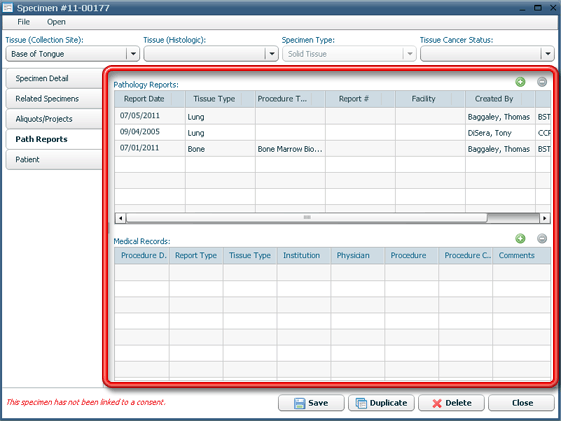
- Click
 above the Pathology Reports list. The Add/Link Pathology Report window will open.
above the Pathology Reports list. The Add/Link Pathology Report window will open.
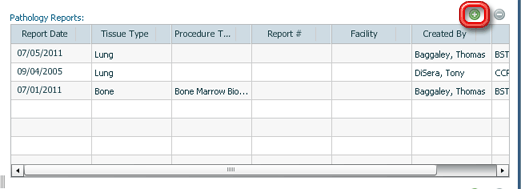
- Select the DEXT tab on that window.
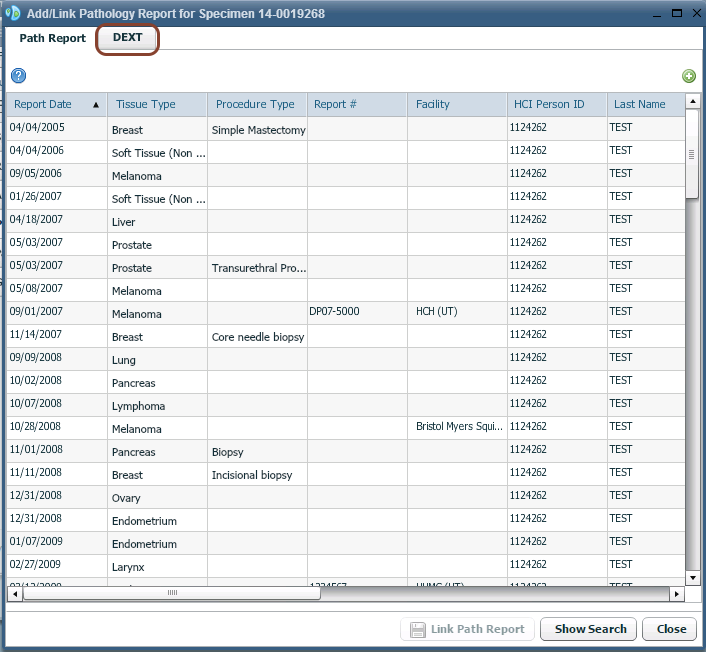
- Select an ITS report to import in the list at the top of the window. (The report will be identified by its SPR number and date.)
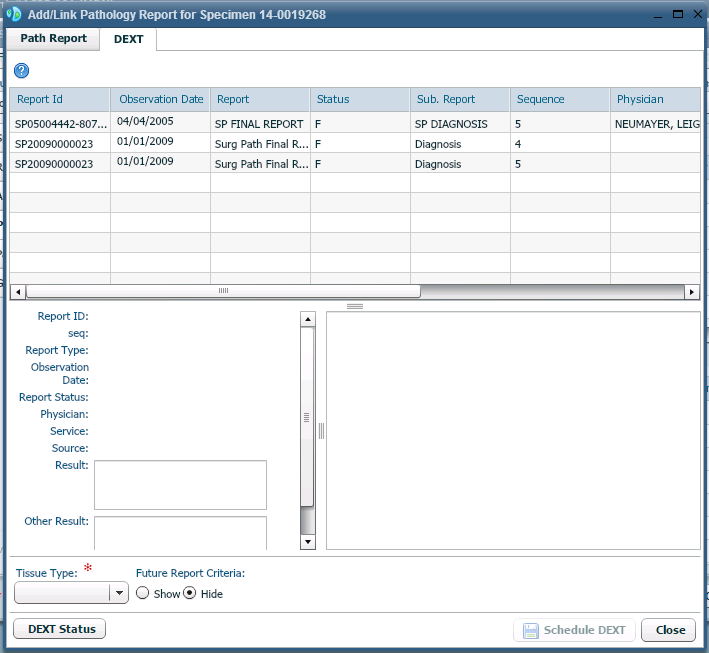
- Select the appropriate Tissue Type in the field in the lower left corner of the window. The tissue type is used to identify natural language processing script that will be used to populate the database fields in the Path Report record.
- If the appropriate Tissue Type does not appear as an option in the drop-down field, a script has not yet been created to perform a natural language processing import of this kind of pathology report. The data will need to be entered manually using some of the other tools that are available to pathology report entry. Contact Research Informatics about the possibility of developing new DEXT natural language processing scripts.
-
Click
 in the lower right corner of the window. The import will not happen immediately. DEXT imports are run in nightly batches.
in the lower right corner of the window. The import will not happen immediately. DEXT imports are run in nightly batches.- To check on the status of a scheduled DEXT import, click
 in the lower left corner of the window. A new window will open.
in the lower left corner of the window. A new window will open.
- To check on the status of a scheduled DEXT import, click
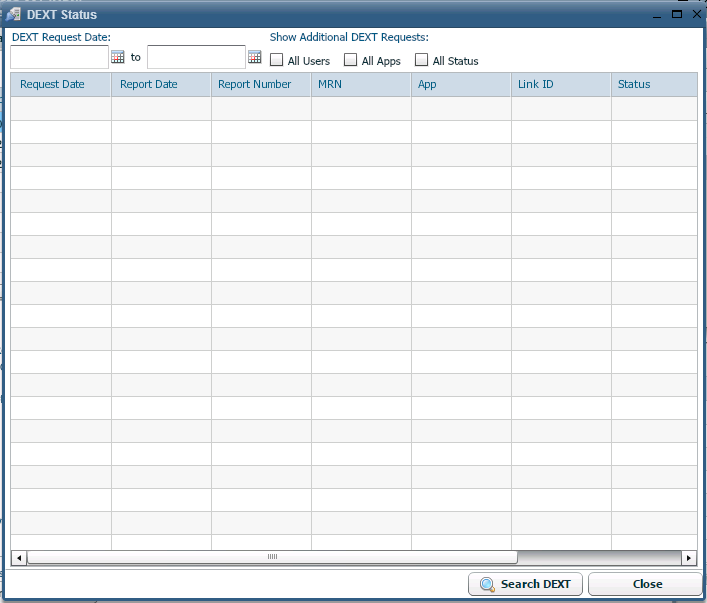
-
Select a date range and click
 . If the report is not yet available for importing, the DEXT script will continue to attempt to import the record until it becomes available.
. If the report is not yet available for importing, the DEXT script will continue to attempt to import the record until it becomes available. -
Once the DEXT import has taken place, verify the data in the pathology report record to ensure the results of the import are accurate. Select File-Mark as Reviewed (DEXT) in the menu bar of the Path Report Detail window for the pathology report to indicate that the import has been properly reviewed.




